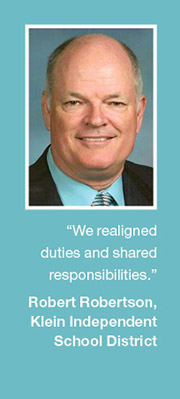Klein ISD: Data, Benchmarking Keys To Reducing Operating Costs
Part 3 of a 6-part article profiling the 2016 FMXcellence honorees.
Between 2008 and 2014, the Klein Independent School District in Texas reduced its annual operating costs by more than one-fifth, while maintaining quality service. The effort to upgrade processes and operations was driven by Robert Robertson, associate superintendent, facility and school service, along with the facilities staff. Klein ISD operates more than 50 schools and ancillary facilities for 50,500 students.
In 2008 Klein, like many districts, faced financial pressures due to the downturn in the economy. Robertson worked with Benchmark4Excellence, which helps school districts identify areas within their organizations where they can boost operational efficiency. Benchmark4Excellence collects audited financial data and operational data across fifty key performance indicators to identify, for instance, how each district’s cost to maintain its buildings compares to other districts.
 Among the findings: Compared to its peers, Klein’s custodial department was overstaffed by about sixty, while its maintenance area was slightly understaffed. In addition, it had substantial opportunities in energy management.
Among the findings: Compared to its peers, Klein’s custodial department was overstaffed by about sixty, while its maintenance area was slightly understaffed. In addition, it had substantial opportunities in energy management.
Robertson was able to reduce the district’s custodial staff relying only on attrition. “Within a year, we were right on the button with our numbers,” he says.
He also was able to secure funding to invest in upgraded custodial equipment, such as high-productivity floor machines and touchless cleaning system for restrooms. Through the equipment and by modifying cleaning schedules, the square footage for which each custodian was responsible jumped from 17,000 to 28,000. “We realigned duties and shared responsibilities,” Robertson says.
Robertson and his team worked with a district-wide energy committee to adjust HVAC and lighting schedules to reduce energy consumption. They turned off exterior and parking lot lights when facilities weren’t in use. The district also invested in a software program that powers off the roughly 60,000 computers across the district after 5 P.M., once they’d been inactive for fifteen minutes. Robertson says the $100,000 investment in the program generated savings of $500,000 its first year.
To be sure, the team encountered some challenges in its efforts to reduce costs. Some employees were concerned about the time required to collect information for the benchmarking process, and the value of doing so. Efforts to change processes that had been in place a long-time, and thus were familiar to employees, also sparked some concern. Communication, a team approach, and training were key to gaining internal buy-in. “You can’t do this in a vacuum,” Robertson says.
While the initial data collection was a bit arduous, the process today is straightforward and well understood, Robertson says. The facilities staff focuses on six key performance indicators, including square feet of cleaned space per custodial employee, kilowatt-hour consumption per square foot per year, and maintenance cost per square foot.
Between 2008 and 2014, the facilities management group was able to cut Klein’s energy, custodial, and maintenance expenses from $4.07 to $3.18 per square foot. The district’s chief financial officer noted that the $3 million saved in electricity costs could provide a three percent pay raise for all employees.
Top photo caption and credit: Using energy retrocommissioning recommendations, Klein ISD was able to reduce its annual energy expenses and uncover further opportunities for low-cost/no-cost controls throughout the district. Credit: Stantech Architects
Related Topics:









 Among the findings: Compared to its peers, Klein’s custodial department was overstaffed by about sixty, while its maintenance area was slightly understaffed. In addition, it had substantial opportunities in energy management.
Among the findings: Compared to its peers, Klein’s custodial department was overstaffed by about sixty, while its maintenance area was slightly understaffed. In addition, it had substantial opportunities in energy management.







